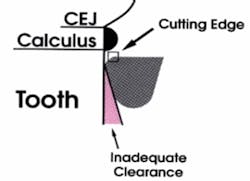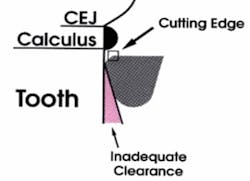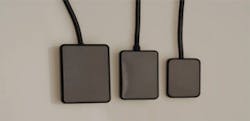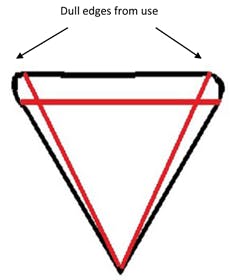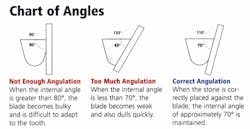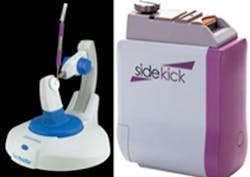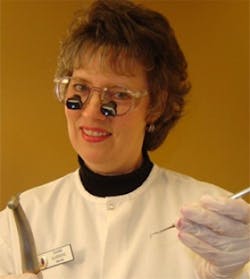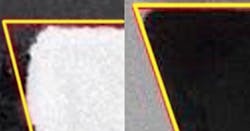No more dull instruments!
Do not use a football to scrape and peel the barn
By Dianne Glasscoe Watterson, RDH, BS, MBA
What can interfere with a hygienist’s ability to scale a patient thoroughly; cause serious hand, wrist, neck, shoulder, and back pain; and shorten a hygienist’s career longevity? Dull instruments. Of all the duties a hygienist must perform throughout the course of a workday, what is the most dreaded duty? Sharpening instruments. Houston, we have a problem!
Try to imagine being tasked with scraping peeling paint off of a building, and the only tool you can use is a football. Now you know what it is like to scrape calcified debris off of a tooth with a dull instrument. Yet, hygienists attempt it every day. Why? The primary reason is because many hygienists have never learned an effective sharpening technique.
Dull instruments are the bane of dental hygienists everywhere. You know when your instrument is dull, because there is no “bite” of the instrument into the surface of the calculus. You try to compensate by pressing harder, which causes physical fatigue. Sometimes, you burnish the surface of the calculus with dull instruments, leaving deposits for microbes to inhabit (see Figure 1).
The instrument blade wears down with each swipe. Eventually the edge, which is formed by the junction of the face and the side of the instrument, becomes rounded. When the blade is very dull, it will reflect light. A sharp edge will not reflect light.
Sickle and curette blade shapes
A sickle scaler is triangular shaped in cross-section. The toe is pointed and the back of the instrument forms a line angle (see Figures 2, 3).
The cutting edges become rounded with use. To re-establish the cutting edges, metal has to be removed either from the face of the blade or the sides, as shown by the red lines in Figure 3.
The curette is half-moon-shaped in cross-section. The toe and back are round. The design of the curette will produce less damage to soft tissues subgingivally, as the rounded toe and back are less likely to puncture tissues than a sickle (see Figures 4,5).
To be effective with any sharpening technique, the clinician must understand (1) the shape of the instrument, (2) how to angle the stone, and (3) maintain the angle consistently while stroking the stone against the side of the instrument. The correct angle of stone to blade is 70°.
Maintaining the perfect angle over a series of sharpening strokes is problematic with manual sharpening. If the angle is too narrow, the instrument blade will be altered and will not be effective in calculus removal. When the angle is too steep, the blade will dull again with very few working strokes (see Figure 6).
Motorized sharpening systems
Many different sharpening systems have been introduced through the years. The most sophisticated sharpening apparatus is the PerioStar 3000™ motorized system. The PerioStar 3000™ by Kerr Dental Specialities (distributed by Integra Miltex in the United States) is the only system in the world that does not rely on the human hand to dictate instrument movement and pressure during the sharpening procedure, as the instrument is clamped into the device while the stone moves around the instrument as it sharpens.
Another popular sharpening accessory is the Sidekick® Sharpener by Hu-Friedy. This power device has instrument guide channels and a vertical backstop to help control blade angulation. It is powered by 2 AA batteries (see Figure 7).
Manual sharpening
An early method of sharpening dental instruments was the “stationary stone” method. The sharpening stone was kept stationary on the tabletop, and the instrument was moved along the stone. The biggest problem with this method was the inability to see and maintain the correct angle of blade to stone.
Later, Hu-Friedy developed a method of sharpening using a clock face to help determine the correct angle for the instrument. The instrument is held in the nondominant hand while the stone is moved against the blade of the instrument. The clinician is supposed to position the terminal shank of the instrument at the 12 o’clock position, and the stone is supposed to be angled at 3.5 minutes after 12 o’clock (or 3.5 minutes before 12 o’clock for left-handers). Again, maintaining that perfect angle over a series of strokes is very difficult.
Most clinicians test for dullness on a test stick. If the instrument does not “bite” into the stick when placed at the proper angle, the instrument is considered to be dull. However, a better solution is to view the instrument blade using a good light and magnification. If the instrument is dull, the clinician can see exactly where the blade is dull; the dull blade will reflect light.
While the primary use for magnification is to increase visual acuity inside the oral cavity, magnification also allows the clinician to see where the blade of the instrument is dull and thereby exercise greater precision in removing only the dull portion (see Figure 8). Designs for Vision® manufactures very high-quality loupes for dental professionals, and their loupes are 100% made in America. They are happy to send their representative to an office to take the necessary measurements and allow the clinician to select the desired frames. All practicing hygienists and dentists should be using magnification (www.designsforvision.com or call 800-345-4009)!
Consider that most instruments get dull at the position on the blade that is used the most, which is the area from the toe extending 3 to 5 mm back toward the terminal shank. Without visualizing the blade, many clinicians remove far more of the blade than is necessary. After all, consider how large the sharpening stone is in comparison to the tiny area, typically 3 to 5 mm, that is actually dull.
Sharpening with a handpiece and cylindrical stone
A simple method of sharpening involves using a high-speed handpiece and small friction grip (FG) stone. The recommended stones are manufactured by Shofu and can be ordered through your local dental supply company. The stones are shaped like a cylinder and come packaged with 12 in a box. The green stone is slightly more abrasive than the white stone and should be used on very dull instruments. The white stone is great for routine sharpening. (Ordering information: Dura-Green Stone CY2: PN 0103 for FG and Dura-White Stone CY2: PN 0243 for FG) An instructional CD-ROM on sharpening with a handpiece and stone plus two prepackaged stones are available at www.professionaldentalmgmt.com (see Figure 9A).
Here are the steps for sharpening with a handpiece:Examine the blade for signs of dullness under a light and with magnification.
- Hold the instrument in your left hand with the face of the blade parallel to the floor and the toe pointed toward you.
- Grasp the handpiece with your right hand and establish a fulcrum on the left hand (see Figure 9B, C).
- Lay the stone flat against the face of the blade (see Figure 9B).
- Press the rheostat and gently swipe the stone toward the toe.
- Remember, a little goes a long way with this method. Use very light pressure. It takes only a few swipes with the rotary stone to remove the dull edge. If the stone is flat against the face of the blade, both sides of the instrument will be sharpened simultaneously.
- Examine under a light and use magnification to see if the edge is sharp. If it does not reflect light, it is sharp (see Figure 9D).
Facial sharpening is recommended for sickle scalers, as both sides of the blade are sharpened simultaneously. Curettes can also be sharpened on the face, but some prefer to sharpen on the blade side. The steps are the same, except the stone is placed at a slight angle on the side of the instrument instead of the face. Always move the stone toward the toe of the instrument.
Instruments that stay sharp
Recently, a new family of instruments has been introduced to the dental world. These instruments, by American Eagle (am-eagle.com), retain their sharp edge much longer than regular stainless steel instruments. The technology is called “XP Technology.” Using the Rockwell C Hardness scale, most stainless steel instruments are in the 58 to 60 range for hardness. American Eagle XP instruments rank at 89 for hardness. Diamond is rated at 100 on the hardness scale.
Figure 10 (left photo) shows a stainless steel scaler after being used 1,500 strokes. The yellow line shows the original shape of the instrument before being dulled by use. The right side of the figure shows an XP instrument after 15,000 strokes. It is easy to see that there is far less wear, even after significantly more strokes, compared to a stainless steel instrument.
One of the more popular American Eagle instruments is called the Scandette. This instrument combines the best features of the Gracey 11/12 and 13/14.The face of the blade is raised in the middle. Therefore, facial sharpening is contraindicated for this instrument.
There are many advantages in using American Eagle instruments:
1. They require little to no sharpening.
2. They are lightweight and ergonomically friendly.
3. The working end of the instrument is thin, allowing easy adaptation of instruments in tight places.
4. Screw-in tips are available, allowing clinicians to customize instruments and reuse handles.
In conclusion
Every dental instrument has a useful life. When an instrument breaks or becomes so thin from sharpening that it is impossible to maintain a sharp blade, the instrument should be replaced or retipped. When purchasing new instruments in the future, clinicians should seriously consider switching to American Eagle instruments because of their ability to retain a sharp edge over the life of the instrument. RDH
Dianne Glasscoe Watterson, RDH, BS, MBA, is a professional speaker, writer, and consultant to dental practices across the United States. She is CEO of Professional Dental Management, based in Frederick, Md. To contact Glasscoe Watterson for speaking or consulting, call (301) 874-5240 or e-mail [email protected]. Visit her Web site at www.professionaldentalmgmt.com.
Past RDH Issues
